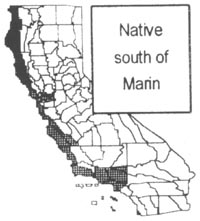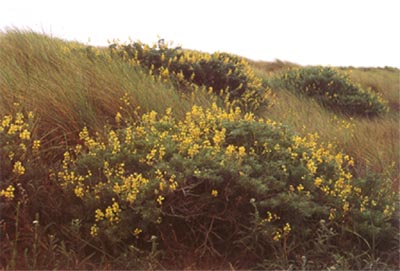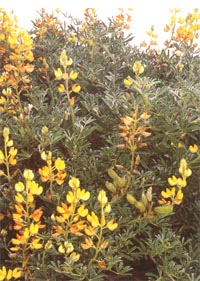|
Lupinus arboreus
|
|
|
|
Scientific name
|
Lupinus arboreus
|
|
Additional name information:
|
Sims
|
|
Common name
|
yellow bush lupine, coastal bush lupine
|
|
Synonymous scientific names
|
Lupinus eximius, L. macrocarpus, L. propinquus, L. rivular
|
|
Closely related California natives
|
70
|
|
Closely related California non-natives:
|
0
|
|
Listed
|
CalEPPC List A-2,CDFA nl
|
|
By:
|
Andrea J. Pickart
|
|
Distribution
|
|
|
HOW DO I RECOGNIZE IT?
Distinctive features:
|
Yellow bush lupine (Lupinus
arboreus) is a bushy shrub to six feet tall, usually with bright yellow
(sometimes blue) sweet-smelling flowers and green, sparsely pubescent (appearing
glabrous), palmately compound leaves. It occurs as an invasive species in
northern California coastal dunes. It appears to be native to California from
Sonoma County south, where plants often have a hairy upper leaf surface. Yellow
bush lupine is predominantly a dune species, but it can be found along roadsides
and in disturbed areas. Flowers appear in May to July in northern California
(earlier in the southern part of its range). Yellow bush lupine hybridizes with
the native L. littoralis, which is smaller (less than two feet) and more
prostrate-decumbent, has purple and white flowers, and always has a hairy upper
leaf surface. Intermediates usually are smaller and more prostrate than L.
arboreus, with blended yellow, purple, and white flowers (Wear 1998). In the
southern portion of its range yellow bush lupine can be easily distinguished
from blue bush lupine (L. chamissonis), which can achieve the same height but
has silver, densely hairy leaves that appear gray-blue and light-violet to blue
flowers.
åÊ
|
|
Description:
|
| Fabaceae. Bushy shrub to 6 ft (1.8 m) tall. Leaves: cauline with stipules 0.2-0.5 in (8-12 mm), petiole 0.8-1.2 in (2-3 cm). Each leaf palmately compound with 5-12 leaflets, 1-3 in (25-75 mm) long. Foliage sparsely pubescent, appearing green-glabrous in northern California and glabrous to hairy in southern portion of range. Inflorescence: panicle 4-12-in (10-30-cm) long. Flowers: bright yellow (rarely lilac to purple), pea-shaped flowers 0.6-0.7 in (14-18 mm). Calyx upper lip two-toothed, 0.2-0.4 in (5-9 mm), lower lip entire, 0.2-0.3 in (5-7 mm). Upper keel margin ciliate from claw to tip, and lower keel margin glabrous, as is banner back. Fruit: brown-black pods, hairy and 1.6-2.8 in (4-7 cm) long. There are 8-12 seeds/pod, each 0.16-0.2 in (4-5 mm), black to tan or striped lighter (Hickman 1993). |
|
|
|
WHERE WOULD I FIND IT?
|
Yellow bush lupine occurs from the mouth of
the Ventura River in California northward to at least Vancouver Island, British
Columbia. It is primarily a coastal plant, but has been found inland east of
Berkeley, California (Sholars, pers. comm.). Yellow bush lupine is native in the
southern part of its current range, although the demarcation between native and
naturalized populations is still disputed. Davy (1902) reported its range as
Point Reyes south. Hickman (1993) suggests that populations as far north as
Bodega Bay are native.
Naturalization of yellow bush lupine and subsequent gene flow
within the genus has resulted in taxonomic and range confusion. Under the
current classification (Hickman 1993), there are both purple and yellow forms of
Lupinus arboreus. For the purposes of identifying yellow bush lupine as an
invasive weed in Humboldt County and north, the problem is simplified by the
fact that the invasive form has yellow flowers. However, there are intermediate
hybrids between the yellow-flowered form and the purple-flowered dune native L.
littoralis (found from Sonoma County to British Columbia). Where L. arboreus
occurs off dunes (e.g., along roadsides), it also hybridizes with the
purple-flowered L. rivularis (found from Mendocino County to British Columbia).
Yellow bush lupine is not yet present on the Ten Mile Dunes at MacKerricher
State Park in Mendocino County. However, a blue-flowered, woody species
identified by by Teresa Sholars as L. arboreus is common at Manchester Dunes in
Mendocino County. These dunes have already been extensively invaded by Ammophila
arenaria, and it is not clear whether yellow bush lupine is increasing at this
site.
|
|
WHERE DID IT COME FROM AND HOW IS IT SPREAD?
|
Yellow bush lupine is native to southern
and central California. It was introduced repeatedly to many dune systems as a
sand stabilizer during the early to mid-1900s. The introduction of yellow bush
lupine to the Humboldt Bay dune system was traced by Miller (1988). In 1908 the
operator of a fog signal station on the north spit of Humboldt Bay gathered
seeds of yellow bush lupine from the Presidio (where it had previously been
introduced) and planted them around the station. In 1917 seeds from the new
signal station population were collected and scattered beside railroad tracks
along the spit. From these and later plantings, the extent of yellow bush lupine
has increased from 244 acres (98 ha) in 1939 to over 1,000 acres (400 ha)
(Pickart and Sawyer 1998). Yellow bush lupine now dominates 28 percent of the
total vegetation cover on Humboldt Bay dunes (Pickart and Sawyer
1998).
As do other members of the genus, Lupinus arboreus has
relatively large seeds with corresponding high seedling survival. Once a
population becomes established, it spreads short distances by rodents or by
seeds rolling from parent plants down dune slopes.
åÊ
|
|
WHAT PROBLEMS DOES IT CAUSE?
|
Yellow bush lupine invades coastal dunes in
northern California, where no other large, shrubby, native lupines are found
(although Lupinus littoralis is sometimes classified as a subshrub). The seeds
of yellow bush lupine are long-lived and form a persistent seedbank, creating
the need for repeated removal. However, more serious problems are caused by
yellow bush lupineÛªs ability to cause ecosystem-level changes. As a
nitrogen-fixer, bush lupine readily colonizes the open, mat-like vegetation of
northern California dunes (known as dune mat, or the Sand-Verbena/Beach Bursage
series). Once the lupine has been present for more than a few years, it causes
elevated nitrogen levels that facilitate invasion by non-native weedy grasses
(Pickart et al. 1998).
Maron and Connors (1996) also observed this phenomenon on
coastal prairies at Bodega Bay, where yellow bush lupine is believed by some
botanists to be native (there is a relict native dune scrub community containing
Lupinus chamissonis at Bodega Bay). Eventually, desirable native species in
invaded areas are almost entirely displaced by a combination of lupine shrubs,
weedy grasses, and/or adventive natives such as Scrophularia californica. This
assemblage of species has been labeled the Yellow Bush Lupine series by Sawyer
and Keeler-Wolf (1995). Eventually, the Yellow Bush Lupine series may give way
to the Coyote Brush series, which otherwise would not occur on northern
California dunes. In both of these situations, plant cover is much higher than
that of the native dune community, so the dune system becomes overstabilized. As
a result, sand is not able to move from the foredunes to the backdunes, and
physical processes are disrupted. This can result in elongation of the deflation
plain behind the foredunes and/or stabilization of the backdunes. Although dunes
are naturally subject to cyclic stabilization and rejuvenation in response to
major tectonic events, exotic species such as yellow bush lupine and European
beachgrass (Ammophila arenaria) can greatly accelerate stabilization and could
conceivably replace dune mat altogether in the post-disturbance stage of the
cycle.
åÊ
|
|
HOW DOES IT GROW AND REPRODUCE?
|
Yellow bush lupine reproduces solely by seed. It is self-compatible and is pollinated by bumble bees (Wear, pers. comm.). Flowering takes place from May to July in northern California, and seed dispersal occurs in late summer and fall. Pods open explosively, propelling seeds for short distances. Seeds are characterized by a hard seed coat, typical of the genus. However, seed coat dormancy is overcome in the dune environment, probably by the abrasion caused by sand and wind, and seedlings emerge from November to March (Pickart and Sawyer 1998).
|
Plants grow rapidly, reaching reproductive maturity in one to two years. Yellow bush lupine plants are short-lived for their size, generally living seven years or less (Davidson and Barbour 1977).
|
(click on photos to view larger image)
|
|
|
HOW CAN I GET RID OF IT?
|
Control of yellow bush lupine has so far
been limited to manual and mechanical means. The cyclic die-offs observed in
both Humboldt Bay and Bodega Bay populations suggest that biological control may
be effective, but more research is needed. Chemical control has not been
attempted. The observed effects of wildfires in the dunes indicate that yellow
bush lupine can resprout after burning, although a very hot fire might kill
these plants. Regardless of the method of removal, additional steps may be
needed to restore soils to a condition suitable for native
vegetation.
åÊ
|
|
Physical control:
|
Manual methods: If yellow bush lupine has been present only a
short time, and native vegetation is still intact beneath the shrubs,
restoration of dune mat can be accomplished by cutting mature lupines at the
base of the trunk and splitting the trunk to discourage resprouting.
Alternatively, a weed wrench can be used to remove the root intact, but this may
prove awkward on steep, sandy slopes. Small plants can be pulled by hand. Plants
should be removed prior to seed set. It may be easier to detect plants during
flowering, but in a large population this could have detrimental impacts on
pollinators. Plants are usually piled on a nearby bare area and burned after a
few weeks of drying. Treatment will need to be repeated for as many years as
plants emerge from the seedbank. To ensure that all plants have been removed,
recheck the area during the flowering period, when smaller plants are readily
seen.
If yellow bush lupine
has been present long enough to alter soils, non-native grasses or other plants
not normally found in dune mat will be present, and a duff layer will have accumulated. In this case lupine can
be removed using the method described above, but this action will
not be sufficient to restore dunes. In addition to removing lupine, all associated
non-native or adventive native plants must be removed, and the duff layer
should be scraped off to reveal the mineral soil (Pickart et al.
1998a). This treatment will need to be repeated for up to four years. The disturbance
caused by this treatment stimulates germination from the seedbank, so bush lupine and other
weeds in the seedbank will be depleted sooner than if bush lupine
alone were being removed. Depending on the amount of remnant native vegetation,
native species may need to be reintroduced.
Mechanical methods: Dune areas invaded by yellow bush lupine
have been restored using heavy equipment in small-scale experiments at Humboldt
Bay dunes (Pickart et al. 1998b). Areas in which few native species remain, and
that are relatively flat and accessible, are suited to this treatment. In the
experiments, all vegetation was removed using a brush rake, followed by scraping
off the duff layer with a plough blade. Weed mat was then placed over the soil
surface, fastened with staples, and left for two years. One year after weed mat
removal, recolonization by lupine and other non-natives was low. The weed mat
apparently killed seeds in the seedbank. Revegetation with native species is
essential for this treatment.
åÊ
|
|
Biological control:
|
No USDA approved biological agents are
known for control of yellow bush lupine. However, at Bodega Bay, where the
species is believed by some botanists to be native, some coastal prairie
populations of Lupinus arboreus have been found to be cyclic in nature, with
cover increasing from zero to as much as 60 percent, then plunging back to zero
within three to ten years (Strong et al. 1995a). Population fluctuations have
been linked to herbivory by subterranean ghost moths (Hepialus californicus),
whose populations are in turn controlled by entomopathogenic nematodes (Strong
et al. 1995b). In naturalized populations at Humboldt Bay, similar cyclic
die-offs have been observed. No ghost moths have been detected, but many other
herbivores, as well as fungal pathogens, are present. In 1996-97, during a major
dieback, the ÛÏVGC-2Û strain of the fungus Colletotrichum gloeosporoides, was
collected from affected plants. This fungus has caused significant mortality in
cultivated yellow bush lupine in New Zealand (Dick 1994).
åÊ
|
|
Chemical control:
|
No chemical control techniques have been
investigated for this species.
åÊ
|




